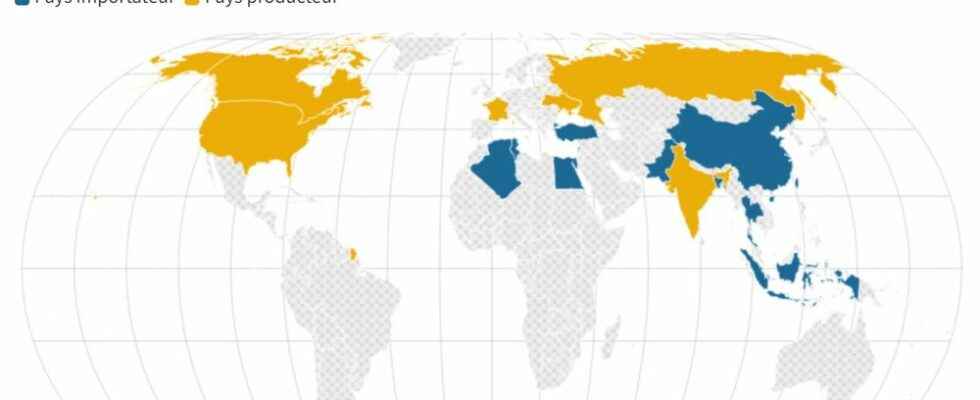India promised to “feed the world” in response to the war in Ukraine. It will henceforth be content to put water in the mouths of neighboring and distant peoples. Hit by an intense heat wave, where temperatures are around 50 degrees and farms have been devastated, the country is suffering a decline in its wheat production.
The world’s second largest wheat exporter, New Delhi has chosen to preserve its raw material for the domestic market and its population. The objective was clearly stated by the government: to ensure the “food security” of the inhabitants in this country which has 1.4 billion inhabitants.
A decision that breaks with the ambition of the government to supplant Ukrainian agricultural production, destroyed by the bombings on its soil. While export contracts concluded before the decree can be honoured, future exports are frozen unless special authorization is granted. This means that the state will approve import requests from foreign powers on a case-by-case basis. This is a significant change in trade relations between exporting countries and importing States. Breaks in the food balance are to be expected in the region and in the rest of the world.
The main wheat importers (in blue) have to deal with a scarcity which mainly benefits the producing countries (in yellow).
Flourish
If you are not viewing the infographic, Click here.
An increased risk of famine
“If everyone starts imposing such export restrictions or even closing markets, it will only worsen the crisis and it will also harm India and its farmers,” warned the German Minister of Security. Agriculture, Cem Özdemir, following a meeting with his counterparts at the G7. Members of the panel called on India to leave markets open, fearing a risk of famine.
With the war that has sprung up in Ukraine, around 20 million tons of grain are blocked in the war territory due to the blockade imposed on Ukrainian ports. This had an immediate effect on wheat prices, which instantly shot up, pointing to shortages in many parts of the world. These shortages pose a risk of famine and social unrest, particularly in the poorest countries, which massively import cereals both to feed livestock and for populations.
India’s decision to pull out poses an immediate risk to the sector, so worsening shortages are not a science fiction scenario. With the withdrawal of Indian wheat, the resource should become even scarcer, paving the way for an explosion in prices. The richest countries will be able to follow the surge in prices when the poorest will have to give up their cereal imports, further reinforcing the food inequalities that cross the globe. Moreover, countries able to obtain supplies of other resources – such as rice or fruit and vegetables – will do without wheat and will see neither their finances nor their food balances disturbed.
Wheat inequality map
In this context, it is undoubtedly Egypt which is the country most affected by this wheat crisis. The world’s largest importer of cereals, the country got nearly 60% of its supplies from Ukraine and Russia. “They were our main suppliers of wheat,” Egyptian Prime Minister Mustafa Madbouly acknowledged in early March. In a rebound from the war in Europe, North African power turned to India and planned to buy at least a million tons of Indian wheat. If the Indian government wanted to be reassuring – the commitments made before this month of May will be honored – Egypt must now find another partner for the months to come.
Its neighbors like Tunisia and Morocco are also countries that should suffer from the rise in the price of wheat linked to the Indian withdrawal. Same story in Lebanon, which had also moved closer to India in recent weeks. Faced with a constant food and social crisis, the Lebanese population should suffer from this new blow.
Despite the rise in prices, other countries are less affected, such as China, which had further diversified its supplies. Moreover, it was already importing from some of the most expensive suppliers on the market, such as the United States. At the same time, several Asian countries believed in the Indian promise to impose itself, in the light of the Russian-Ukrainian conflict, as the pantry of the continent. Bangladesh, which wanted to strengthen its trade with its neighbour, had taken a step in this direction. In 2021-2022, of the 7 million tonnes of wheat produced in India, almost half had been exported to Bangladesh, recalls the Indian media The Hindu.
The world’s second largest wheat producer was on its way to becoming a notable exporter. Thailand or Indonesia, massively affected by the economic consequences of the war, could have turned to New Delhi. India has chosen to fall back on its initial strategy: to produce for domestic purposes. This raises the specter of a dormant phenomenon: a protectionist shift in exporting countries. This decline has already been observed in Indonesia, which has suspended palm oil exports, while Serbia and Kazakhstan have themselves imposed quotas on grain exports. The bowl of cornflakes for breakfast will perhaps, in several months, be a luxury reserved for countries that cultivate them.
